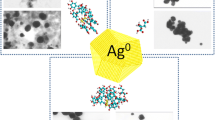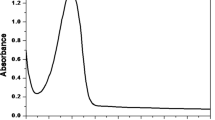Summary
The interaction ofγ-Al2O3 and polyanions of different classes of substances was investigated by means of adsorption and measurements of the electrokinetic potential. Whereas the isotherm (pH 7, 25 °C) of sodium sulfate is of theLangmuir type those of sodiumtripolyphosphate, mellitic acid, ethanehydroxy-1. 1-dip hosphonic acid, phosphonoacetic acid, α-phosphonopropionic acid, and nitrilotriacetic acid are of the high affinity type. Some polyanions attack the alumina surface strongly through the formation of soluble Al-complexes. Because of this effect the scale of equilibrium concentration is shifted towards the origin, and consequently the slope of the isotherm is affected in a complicated fashion. Therefore, it is impossible to calculate the affinity between anions and solid surface from the rise of the isotherms. On the other hand a ratio of surface coverage and molecular cross section derived from the values of saturation enables to establish a sequence of affinities. Adsorption is strongly pH-dependent. A significant decrease is observed with increasing pH. Adsorption is increased with increasing temperature. Since adsorption enthalpies of alumina in the solutions of the polyanions are about those in pure water, entropy should control the adsorption process. The IEP of the solid is about 9. A very small shift of IEP is observed in the presence of sodium sulfate whereas those of the polyanions cause a strong one in the direction towards lower pH (pH < 2). In addition a significant increase of pH is observed when the solid is dispersed in the solutions of polyanions. All data indicate that chemisorption of the investigated polyanions at the alumina surface occurs whereas for sulfate physisorption probably takes place.
Similar content being viewed by others
Literatur
Balzer, D., unveröffentlichte Untersuchungen.
Van blazer, J. R. undM. E. Tuvell, J. Amer. Oil Chem. Soc.35, 552 (1958).
Joyce, I. H. undW. E. Worall, Trans. Brit. Ceram. Soc.69, 211 (1970).
Bidwell, J. I., W. B. Jepson andG. L. Toms, Clay Minerals8, 445 (1970).
Lange, H., Abh. dtsch. Akad. Wiss. Berlin, Kl. Chem., Gerl. Biol. Jahrg. 1966, Nr. 6b, 895 (1967).
Blaser, B., K. H. Worms, H. G. Germscheid undK. Wollmann, Z. anorg. allgem. Ch.381, 247 (1971).
Coover, H. W. et al., J. Amer. Chem. Soc.78, 1963 (1957).
Kosolapoff, G. M., J. Amer. Chem. Soc.68, 1104 (1946).
Haleman, Analytical Chemistry of Phosphorous Compounds, S. 32 (New York 1972).
Wiersema, P. H., A. L. Loeb undJ. Th. G. Overheek, J. Coll. Interf. Sci.22, 78 (1966).
Koch, 0. G. undG. A. Koch-Dedic, Handbuch der Spurenanalyse (Berlin-Heidelberg-New York 1964).
Kabachnik, M. I. et al., Dokl. Akad. Nauk. SSSR177, 582 (1967).
Stumm, W., J. N. Butler andY. R. Chen, J. Coll. Interf. Sci.43, 421 (1973).
Muljadi, D., A. M. Posner undJ. P. Quirk, J. Soil Sci.17, 238 (1966).
Giles, C. H., T. H. Mac Evan, S. N. Nakuwa undD. Smith, J. Chem. Soc.3973 (1960).
Dobias, B., Privatmitteilung.
Vold, R. et al., J. Phys. Chem.62, 1958 (1958).
Kitchener, J. A., J. Photogr. Sci.13, 152 (1965).
Zettlemoyer, A. C., Ind. Eng. Chem.57, 27 (1965).
Skewis, J. D. undA. C. Zettlemoyer, Int. Kongreß für Grenzflächenaktive Stoffe, Vol. I, 401 (Köln 1960).
Parks, G. A., Chem. Rev.65,177 (1965).
Modi, H. J. undD. W. Fuerstenau, J. Phys. Chem.61, 640 (1957).
Overheek, J. Th. G., Colloid Science, Vol. 1, 160 (New York 1952).
Verwey, E. J. W. undJ. Th. G. Overheek, Theory of the Stability of Hydrophobic Colloids (New York 1948).
Muljadi, D., A. M. Posner undJ. P. Quirk, J. Soil Sci.17, 212 (1966).
Hingston, F. J., R. J. Atkinson, A. M. Posner undJ. P. Quirk, Nature215, 1459 (1967).
Wade, W. H. undN. Hackerman, J. Phys. Chem.64, 1196 (1960).
Peri, J. B., J. Phys. Chem.69, 211, 220 (1965).
Cornelius, E. B. et al., J. Phys. Chem.59, 809 (1955).
McCafferty, E. undA. C. Zettlemoyer, Disc. Farad. Soc.53, 239 (1971).
Young, G. J., J. J. Chessick undF. H. Healy, J. Phys. Chem.60, 394 (1956).
Author information
Authors and Affiliations
Rights and permissions
About this article
Cite this article
Balzer, D., Lange, H. Zur Wechselwirkung von Polyanionen mit Pigmenten. Colloid & Polymer Sci 253, 643–657 (1975). https://doi.org/10.1007/BF01462009
Received:
Issue Date:
DOI: https://doi.org/10.1007/BF01462009




